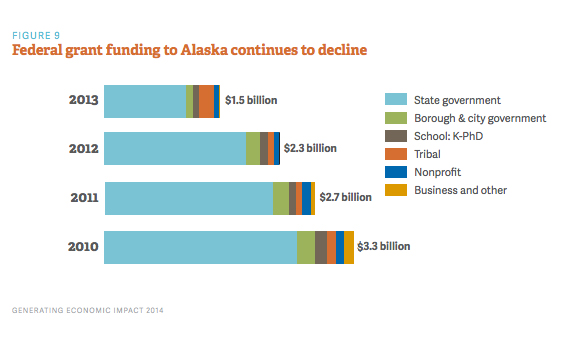A recent study about Alaska non-profits confirms what many in the field know: that federal grant money has been drying up over the past couple of years. On the other hand, it shows that non-profits are developing new revenue streams, and counting on personal giving, particularly in rural areas.
Andrew Cutting is Director of Non-profit Research and Partnerships at the Anchorage-based Foraker Group, which offers training and assistance to Alaska non-profits. He says their study shows that Alaskan are generous.
“Alaskans are very giving. I mean some of these statistics just point to the dollar amount but we know they’re giving in many ways. But this really gives us hard numbers about how Alaskans are giving in their communities and we see that in rural communities they’re giving at a much higher percentage than in urban areas,” said Cutting.
In 2010 Alaska non-profits received 3.3 billion dollars from the federal government. By 2013, that number had been cut by more than half to 1.5 billion, and it’s expected to continue to decline in the current economic climate.

The study shows that nonprofits are counting on earned revenue, which has grown substantially, and personal contributions to make up for the gap. Southwest Alaska residents stand out in their giving.
The Lower Kuskokwim’s giving ratio, based on itemized tax returns, is 3.5 percent compared to 2.7 percent in Anchorage. That’s above the national average of 3 percent.
“Bethel tends to be one of the outstanding ones. We always see blips in communities over time … but Bethel tends to be higher than average and higher than the state year after year, after year,” said Cutting.
Overall, the study says Alaska non-profits are adapting by finding new sources of earned revenue, such as selling goods and services, as federal and state grants are reduced. Cutting says non-profits will have to be nimble, adjusting their funding strategies and diversifying their funding sources over the next few years. He adds that the shift to local giving creates a new narrative for rural Alaska.
“The old story of the villages outside of the main hubs taking, taking, taking isn’t totally true in a lot of ways. Village communities are really taking care of themselves by donating at very high percentages,” said cutting.
Alaska has a lot of non-profits, about 5,700, which are providing a substantial number of jobs. Health and social services dominate the non-profit sector in the state and nationally. The national norm for non-profit employment is 10.6 percent. In Alaska it’s 12 percent. In rural Alaskan communities that percentage tends to be even higher – for example in the Yukon-Kuskokwim Delta where the non-profit sector accounts for half of the workforce, including many through the region’s largest employer, the Yukon Kuskokwim Health Corporation.
Here is a link to the study.
Daysha Eaton is a contributor with the Alaska Public Radio Network.
Daysha Eaton holds a B.A. from Evergreen State College, and a M.A. from the University of Southern California. Daysha got her start in radio at Seattle public radio stations, KPLU and KUOW. Before coming to KBBI, she was the News Director at KYUK in Bethel. She has also worked as the Southcentral Reporter for KSKA in Anchorage.
Daysha's work has appeared on NPR's "Morning Edition" and "All Things Considered", PRI's "The World" and "National Native News". She's happy to take assignments, and to get news tips, which are best sent via email.
Daysha became a journalist because she believes in the power of storytelling. Stories connect us and they help us make sense of our world. They shed light on injustice and they comfort us in troubled times. She got into public broadcasting because it seems to fulfill the intention of the 4th Estate and to most effectively apply the freedom of the press granted to us through the Constitution. She feels that public radio has a special way of moving people emotionally through sound, taking them to remote places, introducing them to people they would not otherwise meet and compelling them to think about issues they might ordinarily overlook.




